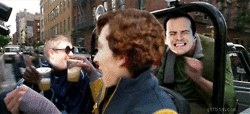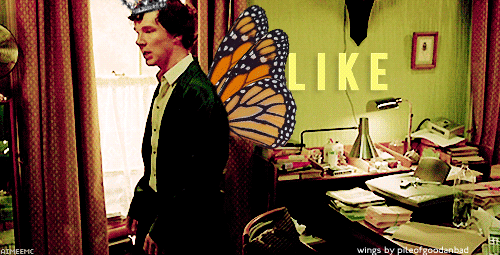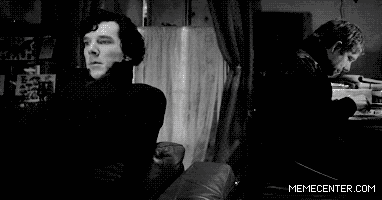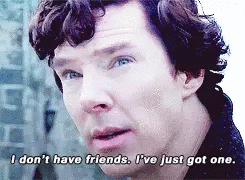GIF me a Fan: An analysis on fan-group creative collective culture through the use of GIFs
By Dania Elahi, Lisa Lan, Nahal Sheikh
Introduction
Who doesn’t love GIFs? There is something magical about this looping animation clip that grabs our attention and makes us all addicted. This visual communication tool has become the ubiquitous visual language used by people around the world in instant messaging, online blogging and social media sites. However, where GIFs are most heavily used is undoubtedly the online fan community. Newman suggests that GIFs’ “most important users so far have been communities of fans who make and circulate them within a participatory culture.” Everyday, fan communities on Tumblr, Reddit, Weibo, etc. are enthusiastically making and sharing GIFs from their favorite shows as part of their fan fervor. They create, appropriate and share GIFs so adeptly as though these were some encrypted code only understood or a new form of ritual only performed by fans.
While online platforms are not the focus here, they are integral parts of fan activity; providing spaces to create and use GIFs as part of their fandom culture. Some are more adapted to fandom interactions than others, such as Tumblr, which is one of the thriving platforms for such practices (Hillman et al.). Allowing for easy sharing and distribution, these mediums provide a process of curation for content, allowing users to express themselves and assert their collectiveness as fans of a certain celebrity, music band, film, Television series, or more (Hautsch).

In order to explore how fans create and interact with GIFs, we have chosen the online fan communities of the BBC Television series ‘Sherlock’ 2010-2017 (Sherlock). This selection was based on the historical weight Sherlock as a narrative carries. Originally written as fiction literature by Arthur Conan Doyle in 1886, the story has experienced infinite adaptations in literature, theatre, film, and TV (Sherlock Holmes). In contemporary digital society, how this classic literature’s relevance has transcended into online interactional spaces renders the case study worth exploring within the GIF-oriented fandom culture. So, how can we connect such GIFs to the inner cultures of communities who create them? By analysing fan-created Sherlock GIFs, we theoretically examine ways in which GIFs’ features offer affective affordances, and how these help construct a creative and participatory in-group culture unique to fan communities.
Intersecting theory with online Sherlock fan groups
According to Burgess, vernacular creativity is an individual’s use of their extraordinary creativity through new media environments. The creativity eventually reaches a large group of people through the effects of fandom, creative activism and game cultures. GIFs provide a medium where users can use their creativity to produce content according to their interests. GIFs’ features grant certain affordances that help generate a powerful creative force and in turn, stimulates fan productivity (Milner & Highfield; Katz & Shifman). Through the productive creation and use of GIFs, this digital media object has a strong impact on in-group culture, i.e. its collective emotions and aspects of identity (Fiske).
Here, the concept of ‘affordances’ is borrowed from Gibson who claims “the affordance of anything is a specific combination of the properties of its substance and its surfaces taken with reference to an animal” (127). This means the environment and objects that surround an individual offer one “physiological and behavioural activities” through their characteristics, dependent on how the individual perceives them (129). In the case of Sherlock’s online followers, GIFs offer them ‘affective affordances’ – possibilities to express emotions and thus communicate with others (Slaby et al.). GIFs as a medium constitute specific characteristics. We isolate two main GIF features; namely its technical composition and its meaning-making capacity through de-contextualisation and re-interpretation. These features offer users affective affordances which help produce a sense of vernacular creativity, contributing to and promoting a creative participatory in-group culture for these fan communities.
In the digital age, GIFs have become key communication tools due their features and affordances (Miltner and Highfield). Bakhshi et al. conducted a study on GIFs, where they found that users preferred GIFs to videos and images as a way of visual communication as they effectively express emotions while demanding less bandwidth from the viewer. By isolating original context, gestures and facial expressions from the Sherlock TV series, fans appropriate their visual cues as their own embodied communication, often for an emotional or humorous effect (Brown). This is a creative process users engage in which impacts and supports a sense of participatory and collective culture within fan communities. As different members explore different Sherlock sources, they add subjective meanings and contexts to them. A more in-depth analysis of how this creative process takes place will follow, taking the features of a GIF as a starting point.
Analysis
GIFs & their technical composition
GIFs (Graphics Interchange Format) possess a technical format that combines visual features of both static images and videos in a compressed .gif file. They consist of short snippets of film clips or small animations on a continuous loop in the form of a single image frame (Nybro Petersen). Its main material features of repetition, duration, and editable flexibility allow for the activation of its affective affordances which are useful for a specific kind of communication (Miltner and Highfield). The first two features of repetition and duration are interconnected and key in the affective effects. So, what does the short repetition sequence found in GIFs do? For one, it resets a particular action to repeat over and over again by which a new emphasis is created that did not exist prior to the creation of the GIF (Miltner and Highfield). This means it is key in establishing or setting a scene for the creator, and more so the viewer.
For instance, in the vast Sherlock fan groups on Tumblr, many fan-created GIFs found showcases ‘scene creation’. Below, Figure 2 shows four characters: Sherlock Holmes himself, John. H Watson, Moriarty, and Sherlock’s older brother Mycroft Holmes. The GIF’s creator has incorporated the characters’ faces into an unfamiliar setting, a vehicle, where all characters seem to be enjoying themselves by singing, dancing and drinking ice lattes on a drive. Originally the villain, Moriarty is also part of the ‘outing’ alongside Mycroft who Sherlock normally does not get along with. This scene setting is unique and affords a momentary play of emotional expression that never existed in the original TV series.

A second and crucial function of the repetitive loop feature is to heighten and reinforce emotion within the scene. According to Miltner and Highfield, “The loop heightens the scene: what is funny, emotive, silly, or weird after one viewing can become more intensely so with repetition” (6). This means if the GIF is aimed at achieving a particular emotion, such as humor in the above example, repetition allows for the joke to sink in. This sinking in affords the viewer something visually perceptible to realise that humor and consequently produce an expected reaction, of say a smile or laugh. Hence, GIFs are usually employed by fan users to produce an “emotional response, whether excitement, affection, grief, joy, or anger” (Hautsch).

GIFs’ last material feature, editable flexibility, is worth exploring too. This is also termed as what Gursimsek calls ‘remixing’: designing a single frame by a combination of video, imagery and text. Here, the practice of layering is done where a single GIF is made up of several layers. For instance, “animated GIFs that incorporate text elements use layering to incorporate the text” (Gursimsek). Although the first GIF does not include text, there are many fan-created ones that do as seen in Figure 3. In this GIF, additional layers added to the original snippet of animation are the crown, butterfly wings and text “Like a Fairy.” Sherlock flutters his hands in the snippet, a movement linked to that of a flying butterfly in this instance. Here, the graphic organisation of the frame utilises both image and text onto the original video as smaller parts of a new and cohesive scene (Gursimsek). So, alongside GIFs’ repetitive format, the process of creation itself, i.e. remixing, is relevant. Together, these material features afford a space for creative emotional expression; making GIFs an extremely unique meaning-making communicative tool for both creator and viewer.
GIFs make meaning: de-contextualisation & re-interpretation
The second GIF feature we analyse is its meaning-making capacity which offers affective affordances through de-contextualisation and re-interpretation (Miltner and Highfield). GIFs are polysemic in nature, given their technical composition. This means different meanings can be employed to one GIF, appealing to its audience to use their creativity to curate their preferred GIF and share it. In order to do this, they first extract a video snippet from the original film or TV series – or de-contextualise – and then re-interpret it; creating a new meaning which fan groups truly understand amongst themselves. Without the original context, the meaning-making becomes subjective, which is usually based on the interpreter’s own imagination (Boxman-Shabtai). In this way, a snippet from Sherlock, put on loop, and shared through different digital platforms has the potential to be interpreted in countless new contexts (Boxman-Shabtai; Miltner and Highfield).
Through de-contextualisation, new narratives are established by users. This new definition given to a GIF is constructed based not just on the GIF’s content but more so on surrounding factors (Boxman-Shabtai). Hence, the meaning can change in any given setting depending on how the user employs the GIF giving it ‘centrifugal multimodality’ where the meaning does not depend on the GIF’s original source, but on the constantly changing surroundings (Miltner and Highfield; Katz & Shifman). For instance, adding captions and messages to GIFs successfully exercises its multimodality, vastly found in Sherlock fan groups.

We can see this multimodality across Sherlock online fan groups. For example, one visible trend seen is the promotion of “fan preferred romantic pairing from a single text” (Miltner and Highfield) in a process of what fans call ‘slash shipping’ – or gay/male pairings – between Sherlock Holmes and John Watson (Romano). In Figure 4, the scene in which Sherlock randomly looks at John with a subtle smile is captured by fans and reinterpreted as an affectionate gesture they claim to be “signs of love” (sissyArmy). This helps support fans’ assertions that “Johnlock (the nickname for the romance between Watson and Holmes) is real” (sissyArmy).

Here, Figure 5 is another example of a fan-preferred-and-imagined romantic scene taking place between the two protagonists. The caption reads: “John? You know I love you?” “Yes.” This never-existing scene is constructed here on a GIF as though it really occurred in the TV series, giving fans what they call an “insane fulfilment” as commented in the Tumblr post (sissyArmy). Similarly, in the examples below, a contrast in contexts is visible. Figure 6 can be used in a myriad of ways because of an absence of text, where Sherlock is simply grinning – an expression applicable to many contexts. However, in Figure 7, the meaning is instantly transformed by adding the text: “High-functioning sociopath, with your number.” These two figures exemplify the process of de-contextualisation by adding a ‘new’ meaning to the original video snippet.


In order to further dissect the process of making new meanings through de-contextualisation, the following GIF combination is an interesting one. It shows how the same context using text can be applied to different video fragments that look similar. In both Figure 8 and Figure 9, the GIFs’ contexts are the same, but the original video source is different. The context here is that of ‘friendship’, where Sherlock claims he does not have friends. In Figure 8, the text reads: “I don’t have friends,” while in Figure 9, it states: “I don’t have friends. I’ve just got one.” This plays with GIF creation in more experimental ways where although the GIF context is the same of ‘not having friends’ and can be used in similar situations, the source varies consisting of different facial expressions by Sherlock. This automatically changes the meaning in Figure 9 where Sherlock seems content with having just one friend, in contrast to Figure 8 where he appears bitter and repulsive towards making friends.


As seen in these section’s examples, a multitude of meaning-making levels can be added to even a single GIF when used outside its original context, which can then be taken in a positive or negative connotation. By this, the original narrative is replaced by another one, where the GIF becomes a new entity with fresh meanings; removed from those who initially created the source meaning. Hence, GIFs’ meaning-making feature offers users affective affordances by de-contextualisation and re-interpretation, allowing – in the case of Sherlock fan groups – for fans to express their emotions regarding the TV series; and contributing to the uniqueness of online fan culture.
Discussion: uniqueness of fan participatory culture
A further point of discussion, and fascination, is the specificity of this computer-generated communication’s nature and how that affects fandom culture. It is found uniquely in online fan groups, such as those of Sherlock, where GIFs as conversational tools encompass and demand participation and creativity from its users, constructing an exclusive type of in-group culture (Jiang). This is well-explained by Henry Jenkins who takes the feature of meaning-making further, and comments in his book Textual Poachers: Television Fans & Participatory Culture that media fans are an ‘interpretive community’ that poaches media texts in order to subvert their original meaning and reclaim ownership of the text; and by large, reclaim ownership of popular culture by subjective means (Jenkins). In other words, interpretation becomes key in fan cultures; GIFs afford this interpretive capacity of fans that surpass forms like text and image because of their format’s “malleability and versatility” (Miltner and Highfield 2). Thus, GIFs engage fans and invite them to freely ‘poach’ the media texts in a playful and creative way according to their own intentions, encouraging a creative and participatory culture (Jenkins).
Similarly, John Fiske brings forward the idea of textual productivity, which in the case of Sherlock fans, stems from the exclusive creative nature of online fandom communication via GIFs. He suggests that “fans produce and circulate among themselves texts which are often crafted with production values as high as any in the official culture” (39). Hence, GIFs with their technical and meaning-making features offer affective affordances and act as texts that allow and invite fan productivity. Through the creation of GIFs, the original Sherlock series can be “worked upon and activated by their fans” (Fiske 41) achieving the “cultural function of circulating meanings and pleasure” (Fiske 42). This way, fans are able to assert their identities as fans of the Sherlock TV series through their membership to a group who participates in a specific type of creative production via GIF creation and dissemination.
Conclusion
By analysing fan-created Sherlock GIFs online, we were able to identify how GIFs’ features offer affective affordances to users. They help in the construction of creative and participatory in-group fandom culture. In particular, we analysed specific GIF features of technical composition and meaning-making capacity through re-interpretation and de-contextualisation in how fan-users express their emotions in reference to Sherlock as a TV series. This framed GIFs as a form of interactional communication amongst group members. In addition, we concluded that GIFs’ features and affordances make them an extremely vibrant creative force within the fan community, encouraging fans’ productivity and empowering them to create their own narratives (Romano). One can never underestimate the creative potential of GIFs, and when GIFs meet fans, this potential is fully unleashed in unique ways (Burgess). Through actively producing and reinterpreting GIFs, fans are making popular culture a truly participatory one. Overall, a creative collective culture found in such fan communities who use GIFs critically hinges on the success of GIFs’ format and affective capacities.
References
Ash, J. (2015). “Sensation, networks, and the GIF: Toward an allotropic account of affect.” Networked Affect, edited by K. Hillis, S. Paasonen, & M. Petit, MIT Press, pp. 119-133.
Boxman-Shabtai, Lilian, and Shifman Limor. “Evasive targets: Deciphering polysemy in mediated humor.” Journal of Communication, vol. 64, no. 5, 2014, pp. 977–998, doi: https://doi.org/10.1111/jcom.12116.
Brown, Katherine. Everyday I’m Tumblin’: Performing Online Identity through Reaction GIFs. 2012. The School of the Art Institute of Chicago, MA dissertation. Academia.edu, https://www.academia.edu/1975475/Everyday_Im_Tumblin_Performing Online_Identity_through_Reaction_GIFs.
Burgess, J. Vernacular Creativity and New Media. 2007. Queensland University of Technology, PhD dissertation. Eprints, https://eprints.qut.edu.au/16378/1/Jean_Burgess_Thesis.pdf.
Fiske, John. (1992). “The Cultural Economy of Fandom.” The Adoring Audience: Fan Culture and Popular Media, edited by Lisa A. Lewis, New York: Routledge, pp. 30-49.
Gatiss, Mark and Moffat, Steven. Sherlock. BBC One. 2010-2017.
Gibson, James Jerome. “The Theory of Affordances.” The Ecological Approach to Visual Perception, Lawrence Erlbaum Associates, Publishers, 1986, pp. 127-143.
Gürsimsek, Ödül Akyapi. “Animated GIFs as Vernacular Graphic Design: Producing Tumblr Blogs.” Visual Communication, vol. 15, no. 3, SAGE Publications, Aug. 2016, pp. 329–49. SAGE Journals, doi:10.1177/1470357216645481.
Jenkins, Henry. Textual Poachers : Television Fans & Participatory Culture. Routledge, 1992.
Jiang, Jialun “Aaron,” et al. “‘The Perfect One’: Understanding Communication Practices and
Challenges with Animated GIFs.” ArXiv:1903.09623 [Cs], 2019, doi:10.1145/3274349.
Katz, Yuval, and Limor Shifman. “Making Sense? The Structure and Meanings of Digital Memetic Nonsense.” Information, Communication & Society, vol. 20, no. 6, Routledge, June 2017, pp. 825–42. Taylor and Francis+NEJM, doi:10.1080/1369118X.2017.1291702.
Miltner, Kate M., and Tim Highfield. “Never Gonna GIF You Up: Analyzing the Cultural Significance of the Animated GIF.” Social Media + Society, vol. 3, no. 3, SAGE Publications Ltd, 2017, pp. 1-11. SAGE Journals, doi:10.1177/2056305117725223.
Hautsch, Jessice. “The Rhetorical Affordance of GIFs by Tumblr’s Supernatural Fandom.” Tumblr and Fandom, vol. 27, 2018, doi: https://doi.org/10.3983/twc.2018.1165.
Newman, Michael Z. “GIFs: The attainable text.” Film Criticism, vol. 40, no. 1, 2016, doi:10.3998/fc.13761232.0040.123.
Nybro Petersen, Line. ‘Sherlock Fans Talk: Mediatized Talk on Tumblr’. Northern Lights: Film & Media Studies Yearbook, vol. 12, June 2014. ResearchGate, doi:10.1386/nl.12.1.87_1.
Romano, Aja. ‘Canon, Fanon, Shipping and More: A Glossary of the Tricky Terminology That Makes up Fandom’. Vox, 7 June 2016,
Sherlock Holmes. The Sherlock Holmes Memorabilia Company, https://sherlockholmes.com/. Accessed 19 October 2020.
sissiArmy. “This is everything I ask to see. Seriously. Nothing more…” Tumblr, 8 March 2017, https://sissidead.tumblr.com/post/158146118419/this-is-everything- i-ask-to-see-seriously.
Slaby, Jan, et al. “Affective Arrangements.” Emotion Review, vol. 11, no. 1, 2019, pp. 3–12. SAGE Journals, doi:10.1177/1754073917722214.
Image source links
Figure 1: “Sherlock GIFs.” Fanpop, https://www.fanpop.com/clubs/sherlock-on-bbc-one/images/33017066/title/sherlock-gifs-photo.
Figure 2: SHERLOCK FANDOM, ARE YOU OKAY? Tumblr, 2013, https://sherlockfandomareyouokay.tumblr.com/post/60569971055/in-case-you-didnt-know-this-is-the-first-scene.
Figure 3: “Sherlock goes True Blood.” SHERLOCK FANDOM, ARE YOU OKAY? Tumblr, 2013, https://sherlockfandomareyouokay.tumblr.com/post/58354245329/sherlock-goes-true-blood.
Figure 4: girls. “THE WAY HE LOOKS AT HIM.” Tumblr, 8 November 2017, https://yuri-on-thin-fucking-ice.tumblr.com/post/167276489227/the-way-he-looks-at-him.
Figure 5: sissyArmy. Tumblr, 8 March 2017, https://sissidead.tumblr.com/post/158146118419/this-is-everything-i-ask-to-see-seriously.
Figure 6: Tyrannical Droid General. Tumblr, 2015, https://generaldroid.tumblr.com/post/112248636186/im-sure-everyone-who-saw-this-reacted-like-this.
Figure 7: “Benedict Cumberbatch Sociopath GIF by BBC.” Giphy, 2017, https://giphy.com/gifs/sherlock-bbc-one-l0HlW5vnelAWvmnO8.
Figure 8: “Sherlock Holmes GIF.” Giphy, 2016, https://giphy.com/gifs/sherlock-holmes-forever-alone-eZJDnsjBwxk2s
Figure 9: ughbenedict. Tumblr, https://ughbenedict.tumblr.com/post/45850646046/sherlock-meme-four-otps-%C2%BC-when-you-came-in